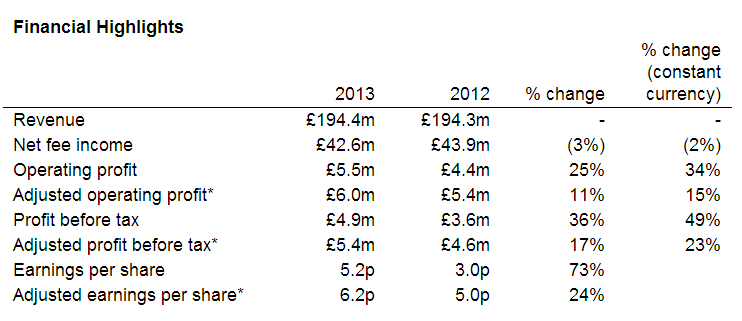Good morning!
Empresaria (LON:EMR)
Results for calendar 2013 have been issued this morning from recruitment group Empresaria. The headline figures look good, so to save re-typing them, here's a screen shot from the results statement:

So an improved profit performance on flat turnover, which seems to have been mainly driven by cost savings in Germany and Austria.
I usually like to check to see what the excluded items are in defining adjusted EPS, to determine whether or not I'm happy to rely on adjusted EPS. In this case they have excluded the following items;
* adjusted to exclude amortisation of intangible assets, exceptional items, gain or loss on disposal of business and movements in the fair values of options
Those look fairly sensible to me, so by stripping those items out the company probably has shown the true underlying performance of the business. The trouble is, companies are stretching these definitions, and many groups now report exceptional restructuring charges every year - so you could argue that restructuring is just ongoing, and a normal part of business.
Anyway, I'm reasonably happy with using 6.2p adjusted EPS as the benchmark figure to value the business on. Put it on a PER of about 12, to come up with what the business might be reasonably valued at, i.e. 72p.
The shares are actually up 11% to 54p this morning, so at first glance they look cheap.
The problem with Empresaria is that it has too much debt. They also have a highly questionable method of reporting it, which I just think is plain wrong. The company reports £5.8m in net debt, which sounds reasonable. However, they have excluded from that figure a further £9.4m in non-recourse invoice financing.
This is presumably where the group has signed over its debtors to a bank, on a non-recourse basis, and they then net off that debt against trade debtors. That is an incorrect accounting treatment, as far as I'm concerned. The principle of no netting off, is one of the fundamental accounting principles! You have to show both the debit and the credit, separately on the Balance Sheet, within trade debtors (for the invoices), and creditors (for the money owed to the Bank).
I've never seen any other company use netting…








